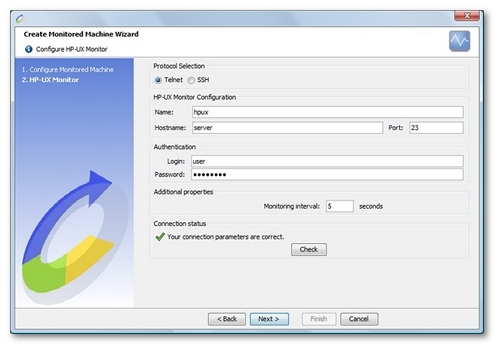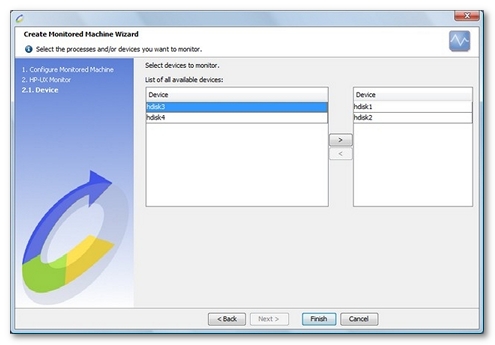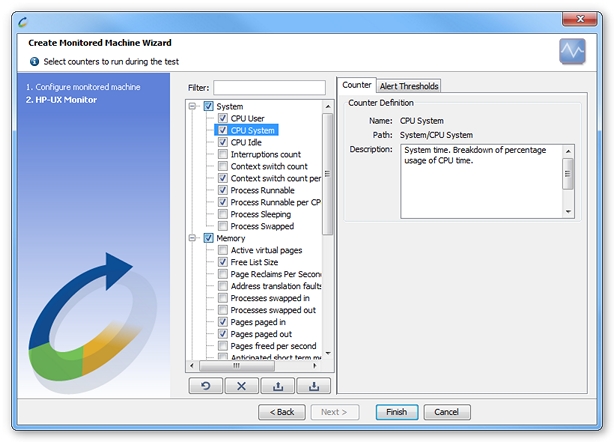HP-UX
Supported versions
The HP-UX monitor has been validated on HP-UX 11.
Connection settings
When creating a new monitor of this type, the protocol must be specified (Telnet or SSH).
Defining a HP-UX connection to a server requires the name or IP address of the machine to be monitored, as well as the connection port. The standard access ports are port 23 for the Telnet protocol and port 22 for the SSH protocol.
A valid user account also must be entered to allow NeoLoad to connect to the server and retrieve the performance counters to be monitored. NeoLoad can open up to three Telnet/SSH connections to the server, depending on the counters to be monitored.
- Warning: With some configurations, repeated connections to the server using the same account (e.g. root account) may not be possible. If this is the case, and depending on the counters selected, certain counters may not function.
Specificities of the SSH protocol
NeoLoad supports the following authentication methods: login / password, private key / public key and Keyboard-Interactive.
On certain systems, the authentication must be configured in the SSH configuration file. If the connection parameters are correct, and the authentication fails, check the SSH configuration in the file /etc/ssh/sshd_config. Check to make sure that one of the following parameters has the value yes: PasswordAuthentication, PubkeyAuthentication or PAMAuthenticationViaKbdInt. The SSH service needs to be restarted for any change to take effect.
NeoLoad also supports the following encryption algorithms (ciphers): aes128-cbc, aes128-ctr, aes192-cbc, aes256-cbc, 3des-cbc, 3des-ctr, blowfish-cbc, arcfour, arcfour128, twofish-cbc, twofish128-cbc, twofish192-cbc, twofish256-cbc, and cast128-cbc.
- Warning: The use of encryption algorithms in certain states may be subject to restrictions.
Lastly, NeoLoad supports the following message authentication codes (MAC): hmac-sha1, hmac-sha1-96, hmac-md5, and hmac-md5-96.
Create an HP-UX monitor
NeoLoad makes it possible to create a new Monitor either using the monitored machine creation wizard, as described in Create and configure a monitored machine, or from an existing monitored machine, as described in Create and configure a monitor.

Depending on the type of counter selected, NeoLoad displays additional steps to select the hard disks (Disk (per device) category counter) to be monitored.

Available counters

The counters available on HP-UX operating system are listed here.
- System.
- CPU User. User time for normal and low priority processes. Breakdown of percentage usage of CPU time.
- CPU System. System time. Breakdown of percentage usage of CPU time.
- CPU Idle. CPU idle. Breakdown of percentage usage of CPU time.
- Interruptions Count. Device interrupts per second (non-clock).
- Context Switch Count. CPU context switch rate (switches/sec).
- Context Switch Count per CPU. Context switch rate per CPU (switches per CPU/sec).
- Processes Runnable. The numbers of processes in run queue.
- Processes Runnable per CPU. The numbers of processes in run queue per CPU.
- Processes Sleeping. The numbers of processes blocked for resources (I/O, paging, and so on).
- Processes Swapped. The numbers of processes runnable or short sleeper (< 20 seconds) but swapped.
- Memory.
- Active virtual pages. Active virtual pages.
Information: Virtual pages are considered active if they belong to processes that are running or have run in the last 20 seconds.
- Free List Size. Size of the free list.
- Pages Reclaims Per Second. Report information about page faults: page reclaims per second. (average each five second).
- Address translation faults. Report information about page faults: Address translation faults per second. (average each five second).
- Processes swapped in. Processes swapped in per second. (average each five second).
- Processes swapped out. Processes swapped out per second. (average each five second).
- Pages paged in. Pages paged in per second. (average each five second).
- Pages paged out. Pages paged out per second. (average each five second).
- Pages freed per second. Pages freed per second. (average each five second).
- Anticipated short term memory shortfall. Anticipated short term memory shortfall. (average each five second).
- Pages scanned by clock algorithm. Pages scanned by clock algorithm per second. (average each five second).
- Active virtual pages. Active virtual pages.
- Disk. The disk section counters are available per device. Outside the wizard, select the device in the counter definition pane. A device picker is available using the Fill devices button. All the Disk counters need the iostat command installed on the server system. This command is a part of the sysstat package. Please make sure that this command is available before using those counters.
- Kilobytes transferred per second. The number of kilobytes transferred per second.
- Seeks per second. The number of seeks per second.
- Millisecond per average seek. The number of milliseconds per average seek.
- Process (per process). The processes section counters are available per process. Select the process identifier in the counter definition pane. A process identifier picker is available using the selection button.
- Process CPU Time. The task share of the elapsed CPU time since the last update, expressed as a percentage of total CPU time.
- Process Memory Usage. Resident size (kb). The non-swapped physical memory a task has used.
- Network (per interface). The network section counters are available per interface. Outside the wizard, select the interface name in the counter definition pane. A network interface picker is available using the Populate button.
- Incoming bytes/s. The number of bytes received by the network interface per second.
- Incoming packets/s. The number of packets received by the network interface per second.
- TCP.
- Incoming segments/s. The number of TCP segments received per second.
- Segments completely duplicated/s. The number of duplicated segments received per second. A segment is duplicated when it is received many times after one or more retransmissions.
- % Segments duplicated. Percentage of duplicated segments received (% Segments duplicated = Segments completely duplicated / Incoming segments * 100).
- Outgoing segments/s. The number of TCP segments transmitted per second.
- Segments retransmitted/s. The number of TCP segments retransmitted per second.
- % Segments retransmitted. Percentage of retransmitted segments (% Segments retransmitted = Segments retransmitted / Outgoing segments *100).
- Retransmit timeouts. The number of timeout triggers for segment retransmissions.